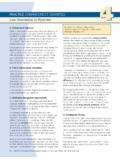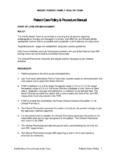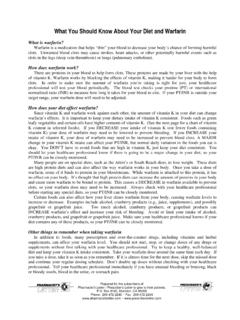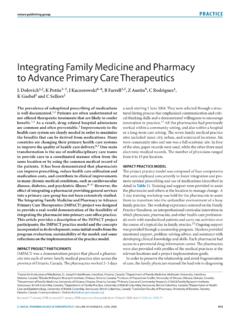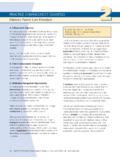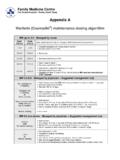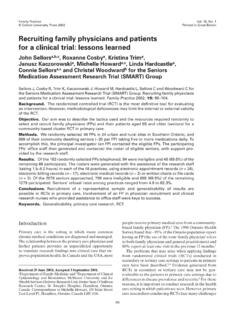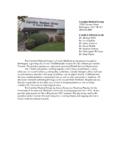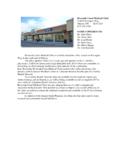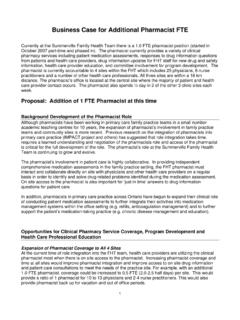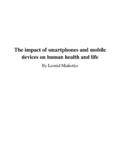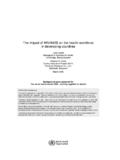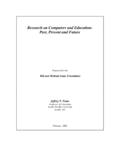Transcription of Case study 29: Warfarin therapy - IMPACT Team
1 case study 29: Warfarin therapyDecember 2003 An Independent, Australian organisation for Quality Use of MedicinesNational Prescribing Service Limited ACN 082 034 393 Level 7/418A Elizabeth Street Surry Hills NSW 2010 Phone: 02 8217 8700 l Fax: 02 9211 7578 l email: l web: 2 Inside case study 29: Warfarin therapy Scenario and questions page 3 Summary of results page 4 Results in detail page 6 Commentaries Dr Denise Ruth page 12 Dr Sepehr Shakib page 14 References page 16
2 The information contained in this material is derived from a critical analysis of a wide range of authoritative evidence. Any treatment decision based on this information should be made in the context of the individual clinical circumstances of each patient. 3 case study 29: Warfarin therapy Scenario Bob, a 65-year-old man with atrial fibrillation, has been using Warfarin for the past 12 months after he presented to the local emergency department with signs of a TIA. A head CT scan and trans-oesophageal echocardiogram done at the time were normal. He has been well since. You have asked Bob to come in to see you as the INR taken this morning was Up until now, his INR results (which have been measured every 2 weeks) have been stable and in the range of He has not started any new prescribed medications recently.
3 Bob also has hypertension and osteoarthritis (for which he had a left total hip replacement 6 months ago). Current medications: atenolol 50 mg once daily, ramipril 10 mg once daily and Warfarin 6 mg at night. On examination: BP 140/80 mmHg; pulse rate 65, irregular. The remainder of the physical examination is normal with no evidence of bruising, epistaxis or gastrointestinal bleeding. 1. List potential drug interaction(s) with Warfarin , which may increase the INR. Foods/beverages Over-the-counter medications Complementary medicines 2. Will you change tonight s therapy ? Yes, please specify: decrease dose; specify new Warfarin dose _____mg OR omit dose number of days Warfarin dose omitted _____days new dose of Warfarin (when restarted) _____mg No change ( continue 6 mg nocte) 3.
4 When would you next measure the INR? 4. How often would you measure the INR during restabilisation? 5. What other measures, if any, would you take to manage the raised INR? Please specify ( other treatment or investigations, communication with other health professionals, patient/carer instructions): 6. List three factors, apart from drug interactions, associated with an increased risk of major bleeding whilst on Warfarin . 4 Summary of results At the time of publication 835 responses had been received from doctors, and 200 of these have been compiled for feedback. Potential drug interactions with Warfarin Foods/beverages: 64% of respondents correctly indicated alcohol may increase INR.
5 33% incorrectly indicated foods/beverages high in vitamin K ( green leafy vegetables and green tea) may increase INR, as vitamin K decreases INR. Over-the-counter (OTC) medications: 66% of respondents indicated nonsteroidal anti-inflammatory drugs (NSAIDs) may increase INR. Conventional NSAIDs can increase risk of bleeding without altering INR, due to antiplatelet effects and a tendency to cause gastrointestinal ulceration. 8% incorrectly indicated vitamin K may increase INR. Complementary medicines: All respondents correctly identified at least one potential drug interaction. 33% incorrectly indicated St John s wort may increase INR, and incorrectly indicated Coenzyme Q10 may increase INR.
6 Both of these decrease INR. 23% indicated ginseng may increase INR. The finding of how ginseng affects INR is less conclusive, as one case report showed a decrease in INR and its exact mechanism of interaction is Changes to Warfarin dose 11% of respondents would decrease the dose of Warfarin tonight. Of these: 81% would reduce the dose of Warfarin to 4 5 mg daily. 86% would omit Warfarin . Of these: 41% would omit the dose of Warfarin tonight 56% would omit Warfarin for more than one day. Of those who would omit Warfarin : 59% would restart Warfarin at 5 mg daily. Next INR measurement 16% of respondents would measure INR the next day 54% would measure INR in 2 3 days.
7 Frequency of INR measurement during restabilisation 20% of respondents would measure INR daily or every second day 75% would measure INR once or twice weekly. Other management 7% of respondents would not employ any other measures to manage the raised INR > 40% would enquire about the use of complementary medicines or dietary changes 16% would check patient compliance with Warfarin . Other factors associated with an increased risk of major bleeding 49% of respondents indicated liver disease as a risk factor for bleeding > 30% indicated uncontrolled hypertension, advanced age or social factors are associated with an increased risk of bleeding whilst using Warfarin .
8 5 Key points The primary threat to patients with atrial fibrillation (AF) comes from ,3 Consider Warfarin in all patients with AF at moderate to high risk of Consider the individual s ability and willingness to cope with the monitoring requirements and risks of Warfarin therapy . Assess contra-indications and bleeding risks, and reassess Patient participation and education are critical in both choosing to start and using For most conditions, including AF, a target INR range of is recommended; specialists may recommend higher ranges in specific circumstances ( for prosthetic heart valves).
9 7 Determine INR more frequently if there are changes in the patient s condition, including intercurrent illness, concurrent drug administration, a change in the amount of alcohol consumed, or a change of 6 Results in detail Question 1. List potential drug interaction(s) with Warfarin , which may increase the INR Table 1: Foods/beverages, OTC and complementary medicines that may increase INR Medication Percentage of respondentsa (n=200) Alcohol Cranberry juice Grapefruit juiceb NSAIDs
10 Vitamins: Type not specified vitamin C (> 5 g per day) vitamin Ec Paracetamol H2 antagonists ( cimetidine and ranitidine)
